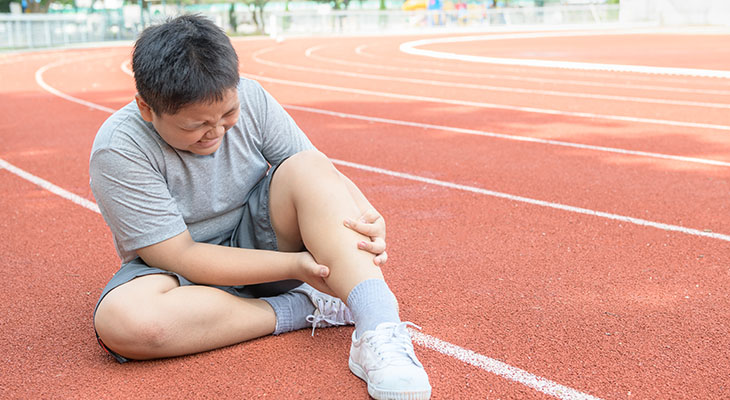Sports overuse injuries in children have increased along with the pressure for students to complete in year-round sports, such as travel and tournament teams.

Sports overuse injuries in children have become quite common as the pressure for students to complete in year-round sports, such as travel and tournament teams, has increased over time.
“Being active and participating in sports is a good thing for kids,” said James E. Moyer, M.D., pediatric orthopedic specialist with Norton Children’s Orthopedics of Louisville, affiliated with the UofL School of Medicine. “But as a general theme, too much of a good thing can be a bad thing.”
Why are children more prone to overuse injuries?
Overuse injuries can affect the muscles, ligaments, tendons and/or bones. As bones typically grow ahead of muscle structures, this automatically can cause pulling or tightness. The added stress, force and repetitive movements in sports, combined with rapid growth development and open growth plates, make young athletes uniquely susceptible to sports overuse injuries.
“Not only are children and adolescents participating in sports at younger ages, their participation has become more intense and specialized in recent years,” Dr. Moyer said. “So, when a child participates in the same sport all year long, and they continually use the same muscle groups over and over, it puts stress on the same areas of the body and can lead to overuse injuries.”
Rest is the best form of treatment for all sports overuse injuries, according to Dr. Moyer. If left untreated, some overuse injuries potentially can shut down a child’s growth plate, cause deformities and require surgical intervention.
Most common sports overuse injuries in children
Sever’s disease. Also called Sever’s apophysitis, a common sports overuse injury in children ages 8 to 12. The pain is caused when tight muscles and tendons, combined with the pressure of running or jumping, cause inflammation in the apophysis of the heel. Treatment involves stretching, ice and foot inserts.
Refer a patient
To refer a patient to Norton Children’s Orthopedics of Louisville, visit Norton EpicLink and choose EpicLink referral to Pediatric Orthopedics.
Thrower’s shoulder. Sometimes called “Little League shoulder,” this overuse injury commonly is seen in sports with overhand throwing movements, including baseball, volleyball and swimming. Usually seen in athletes ages 11 to16, it involves pain and reduced range of motion in the shoulder due to widening of the growth plate. It can present with generalized pain in the throwing shoulder, limited range of motion, decreased velocity or performance. Treatment is rest. Persistent pain or discomfort, in spite of appropriate rest or activity modification, can indicate more severe pathology. In those cases, further evaluation and imaging may be warranted.
Thrower’s elbow. Also called medial epicondylitis, this involves overuse of the medial elbow, one of the last growth plates to fuse. Often seen in athletes ages 15 to 17, it can present with pain in the throwing arm, decreased performance and velocity. Treatment involves activity modification, rehabilitation and appropriate throwing regimen. Persistent pain or discomfort, in spite of appropriate rest or activity modification, can indicate more severe pathology. In those cases, further evaluation and imaging may be warranted.
Ulnar collateral ligament (UCL) tears. UCL tears usually impact higher-speed overhead throwing athletes ages 15 to 19. The condition usually presents with pain in the inner elbow and decreased throwing velocity. Treatment may involve physical therapy or surgery. The surgical repair is also known as Tommy John surgery, named for the Los Angeles Dodgers pitcher who underwent what was a groundbreaking procedure in 1974.
Gymnast’s wrist. The condition is a chronic overload of the distal radius in the growth plate, which usually affects gymnasts ages 12 to 14. Symptoms include pain in the wrist, with or without swelling, tenderness and decreased range of motion. Treatment involves immobilization for several weeks followed by activity modification, pending follow-up examination.
Osgood-Schlatter disease. This is an overuse of the knee that involves the growth plate at the top of the shinbone. Typically it causes pain and swelling below the kneecap. It’s common in athletes ages 10 to 15 in sports that involve running, jumping or quick direction changes (soccer, track, cross-country, basketball, ballet, baseball, softball, gymnastics, etc.) Treatment involves immobilization followed by physical therapy.
Stress fractures. Becoming more common due to year-round sports, stress fractures are caused by repeated stress applied to the same bone. They often are seen in athletes who do a lot of running. The condition causes persistent pain in the leg or hip. Treatment involves activity modification and using rest, ice, compression and elevation (RICE method).
If a child complains of an acute pop, has swelling or experiences pain after a direct fall or other trauma, a fracture or more severe injury should be considered and diagnosed using X-ray.

